Research Interests include:
- Electrohydrodynamics and Electrokinetics
- Ion transport through permselective media
- Active (self-propelling) particles (micro/nano-motors, micro/nano-bots)
- Electrokinetics based Lab-on-a-chip devices
- Microfluidic-based cooling of electronic devices
On-chip desalination and energy harvesting using nanochannels
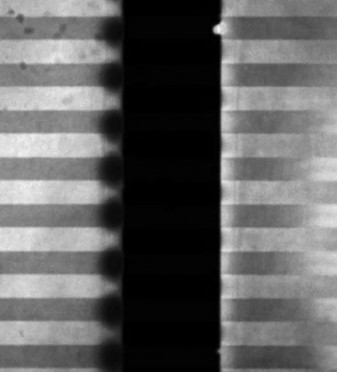
Fabricated microchannel-nanochannel systems share a number of similarities with the older and more well-known field of ion-selective membranes, but it may be the differences which have the most applicative and fundamental scientific importance. In contrast to the highly tortuous, multi-pore and almost ideal ion permselective membrane, the straight fabricated nanochannel exhibits discernible electroosmotic permeability, non-ideal permselectivity and geometrical heterogeneity. Additionally, in contrast to studies using bulk nanoporous membranes, the pseudo two-dimensional microfabricated nanoslot enables direct imaging of the polarized layers, as well as almost absolute control over geometry and surface properties. Understanding the various effects occurring in these different systems is of particular interest for applications such as pre-concentration of analytes, electrodialysis, electroconvective mixing, and biomolecular detection.
Micro-motors
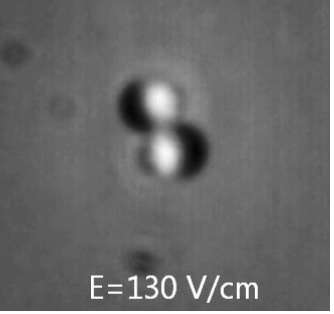 In order to attain net motion of particles under Induced-Charge Electro-Phoresis (ICEP), it is necessary to break the symmetry of the system. Joining two or more metallodielectric Janus particles (JPs) together is shown to exhibit continuous rotation under a uniform AC field. These systems offer multiple potential applications, including portable micromixers and rotors. Such work serves as a tool to further control the direction and alignment of the particles with an eye to their implementation as carriers in chemical and biological analysis system.
In order to attain net motion of particles under Induced-Charge Electro-Phoresis (ICEP), it is necessary to break the symmetry of the system. Joining two or more metallodielectric Janus particles (JPs) together is shown to exhibit continuous rotation under a uniform AC field. These systems offer multiple potential applications, including portable micromixers and rotors. Such work serves as a tool to further control the direction and alignment of the particles with an eye to their implementation as carriers in chemical and biological analysis system.
Induced-Charge-Electro-Osmosis
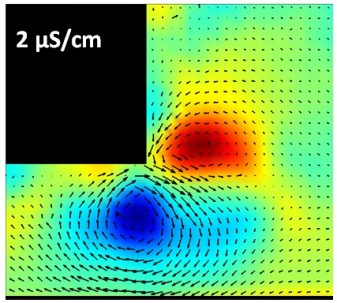 When electrokinetics is combined with “singular” geometries (e.g. sharp tip/corners) the electro-osmotic flow exhibit curious non-linear effects, beyond a critical level of external-field intensity. In particular, vortices appear in the flow around (sharp) corners of micro-channel junctions. This phenomenon possesses considerable engineering relevance in certain applications as a means to enhance and control micro-fluid mixing, particle trapping mechanism and as a forced convection enhancer around “hot spots” for electronic chip cooling. In other situations the appearance of vortices needs to be suppressed so as to avoid aggregation of suspended particles leading to the eventual jamming of the device.
When electrokinetics is combined with “singular” geometries (e.g. sharp tip/corners) the electro-osmotic flow exhibit curious non-linear effects, beyond a critical level of external-field intensity. In particular, vortices appear in the flow around (sharp) corners of micro-channel junctions. This phenomenon possesses considerable engineering relevance in certain applications as a means to enhance and control micro-fluid mixing, particle trapping mechanism and as a forced convection enhancer around “hot spots” for electronic chip cooling. In other situations the appearance of vortices needs to be suppressed so as to avoid aggregation of suspended particles leading to the eventual jamming of the device.
Dielectrophoresis of cells/colloids
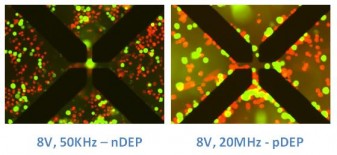 Of all the micro-fluidic sorting technologies, the manipulation of biological particles by dielectrophoresis (DEP) is probably the most broadly applied method. DEP is a technology which uses a nontoxic electrical stimulation to induce a frequency-dependent dipole in cells. In a non-uniform AC electric field, the polarized cells incur a force that can induce them to move to regions of high (positive DEP) or low (negative DEP) electric fields, depending on their polarizability compared with that of the suspending medium. DEP detects inherent cell traits such as surface charge, membrane conductivity and structure, nucleic acid content, cell size, presence and conductivity of internal membrane-bound vesicles and charged cytoplasmic molecules.
Of all the micro-fluidic sorting technologies, the manipulation of biological particles by dielectrophoresis (DEP) is probably the most broadly applied method. DEP is a technology which uses a nontoxic electrical stimulation to induce a frequency-dependent dipole in cells. In a non-uniform AC electric field, the polarized cells incur a force that can induce them to move to regions of high (positive DEP) or low (negative DEP) electric fields, depending on their polarizability compared with that of the suspending medium. DEP detects inherent cell traits such as surface charge, membrane conductivity and structure, nucleic acid content, cell size, presence and conductivity of internal membrane-bound vesicles and charged cytoplasmic molecules.
Microscale heat exchangers
 A gas to gas counter flow micro Heat Exchanger made of an array of microchannels and fabricated using a combination of Silicon and glass wafers is studied. A divergence of the experimental results from the classical heat exchanger theory is observed due to discernible axial conduction effects and heat loss to the environment. Hence, device performance is evaluated using a modified NTU approach that includes also non-negligible axial conduction effects due to the relatively thick and thermally conductive separating wall. This along with replacement of the adiabatic boundary conditions at the separating wall ends with proper temperature conditions enables to evaluate the heat losses to the environment.
A gas to gas counter flow micro Heat Exchanger made of an array of microchannels and fabricated using a combination of Silicon and glass wafers is studied. A divergence of the experimental results from the classical heat exchanger theory is observed due to discernible axial conduction effects and heat loss to the environment. Hence, device performance is evaluated using a modified NTU approach that includes also non-negligible axial conduction effects due to the relatively thick and thermally conductive separating wall. This along with replacement of the adiabatic boundary conditions at the separating wall ends with proper temperature conditions enables to evaluate the heat losses to the environment.
Novel microfluidic platforms for drug screening
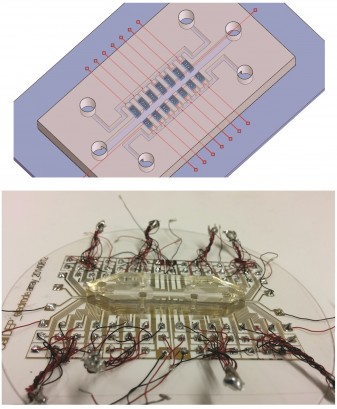 A novel design of reusable microfluidic platform that generates a stationary nanoliter droplet array for cell incubation and analysis, equipped with a complementary array of individually addressable electrodes for each microwell is studied. Various solute concentration gradients were generated between the wells where dielectrophoresis was used to characterize the effect of the gradients on the cell’s response. Lymphoma cells were used as the model cells in these experiments. Lymphoma cells’ crossover frequency (COF) decreased with increasing stress conditions. Specifically, a linear decrease in the cell COF was measured as a function of solution tonicity and blebbistatin dose. Lymphoma cells were incubated under a gradient of the chemotherapeutic agent doxorubicin (DOX), which led to saturation in the cell-COF response at 30 nM DOX, demonstrating the potential of the platform in screening of label-free drugs.
A novel design of reusable microfluidic platform that generates a stationary nanoliter droplet array for cell incubation and analysis, equipped with a complementary array of individually addressable electrodes for each microwell is studied. Various solute concentration gradients were generated between the wells where dielectrophoresis was used to characterize the effect of the gradients on the cell’s response. Lymphoma cells were used as the model cells in these experiments. Lymphoma cells’ crossover frequency (COF) decreased with increasing stress conditions. Specifically, a linear decrease in the cell COF was measured as a function of solution tonicity and blebbistatin dose. Lymphoma cells were incubated under a gradient of the chemotherapeutic agent doxorubicin (DOX), which led to saturation in the cell-COF response at 30 nM DOX, demonstrating the potential of the platform in screening of label-free drugs.
